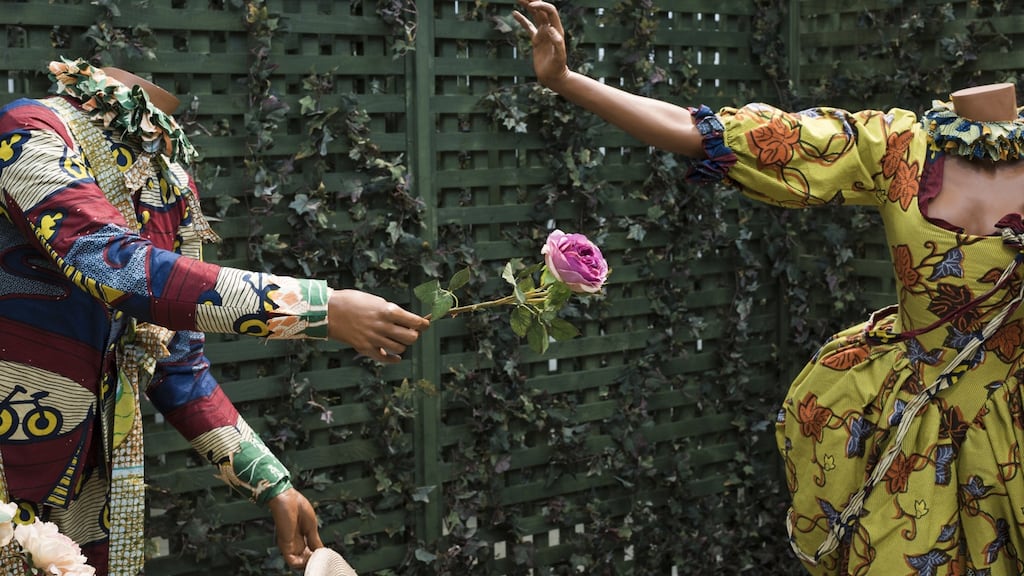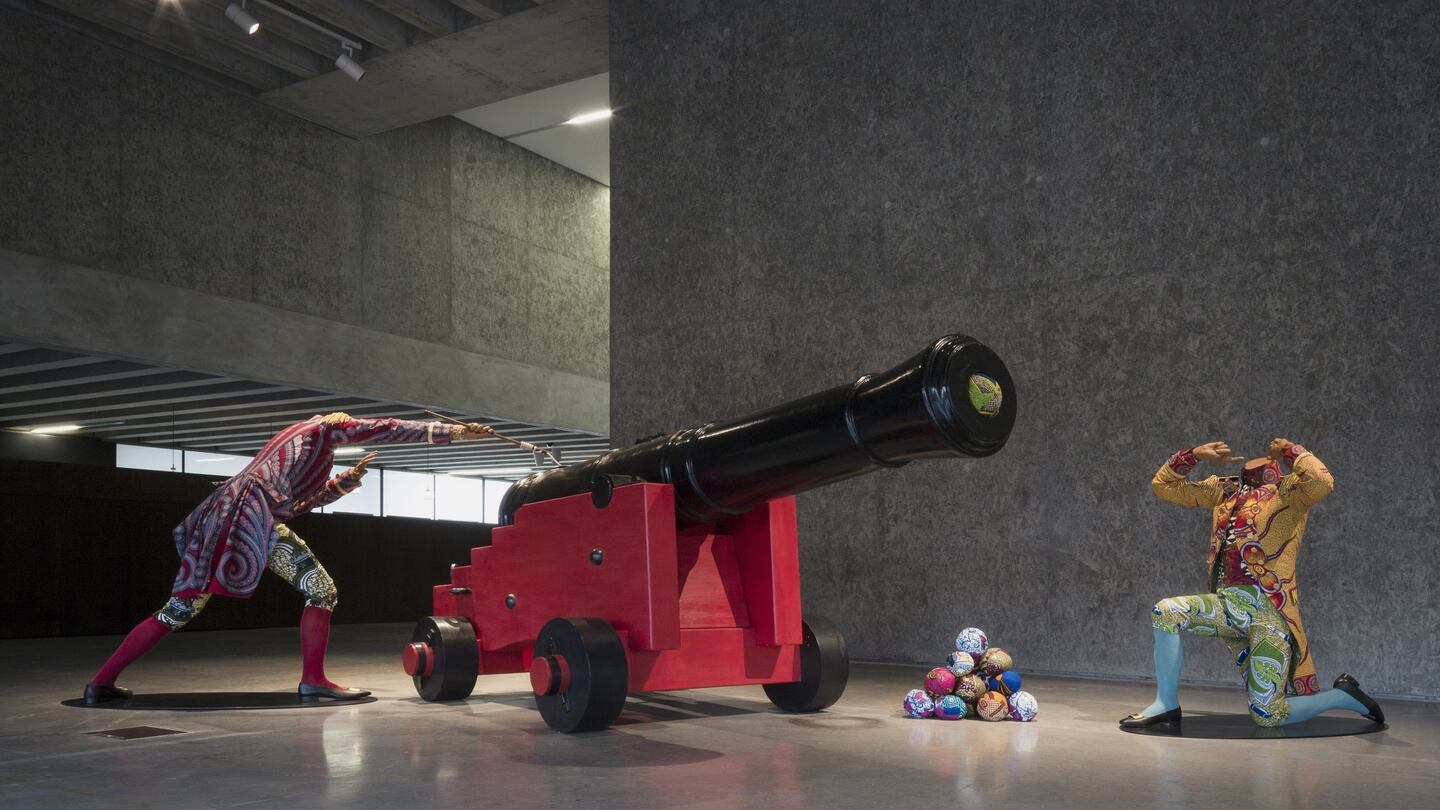As 2016 continues, past Easter weekend with its parades, ceremonies and commemorations, the parallel conversations around colonialism, victimhood and identity have revealed interesting paradoxes. At Visual in Carlow, British-Nigerian artist Yinka Shonibare MBE muses on people’s expectations.
"I didn't understand why I was meant to produce 'authentic' African art," he says, looking back to his student days alongside fellow Young British Artists Damien Hirst, Tracey Emin and Sarah Lucas at London's Goldsmiths college. "I don't disregard tradition, but should an English person make work about Morris dancing?"
Shonibare is tall, dark and handsome, with mad hair, mischievous eyes and a very engaging smile. He is wearing a muted blue-grey checked jacket, dark trousers and funky runners.
0 of 4
Remembering that heady time when art began to make the headlines in Britain, he talks about Margaret Thatcher, the Brixton riots, recession, feminism, immigration and housing issues. Take out Thatcher and Brixton, and you could be talking about Ireland today.
"Artists make works based on what they're seeing and what people are talking about at the time," he says. As we talk, paradoxical ideas creep in. On the one hand, he and his colleagues were taking over abandoned spaces to show their work, because none of them had any money and, on the other, Charles Saatchi was throwing Champagne parties for them.
“I found myself in the middle of all this. There was all this excitement. And because you didn’t have property, because you didn’t have money, you didn’t much care. We just took over spaces and did incredible things.”
Victorian values
Cultural paradoxes were everywhere, providing even more energy. “Margaret Thatcher was talking about returning to Victorian values. And I got very interested in this, because Victoriana – Victorian times in Africa – was not necessarily a happy story. It was a time of colonisation and of racist attitudes.”
The resulting body of work has been exhibited and collected around the world, and earned Shonibare a Turner Prize nomination in 2004, and large outdoor sculpture commissions, including Nelson's Ship in a Bottle for the fourth plinth in London's Trafalgar Square in 2010.
“Do I love the establishment or do I hate the establishment? I thought I was a republican, but then I was invited to Buckingham Palace; I actually liked being there. I was fascinated by everything.” (Hence he added the MBE to his professional name.) “There’s some kind of fascination with monarchy, a sort of a romance of it. After all, I am an artist, so I like all that pomp and all that ceremony. I like the costumes as well, so there’s a natural wanting to challenge the establishment, and I don’t approve, but there’s also that thing of imagining having all of that.”
Humour and intelligence
Shonibare is deeply intelligent and exudes his strong personality and the discipline that has enabled him to continue as an artist despite a viral infection that attacked his spine at the age of 18, leading to one side of his body being paralysed.
He slides by some questions, using humour; he sees that there are at least two sides to almost every question and position.
“We all have a fascination with power, and cyclically we’d all like to have that power ourselves. Unfortunately, most revolutionaries become dictators. It’s a balance, it’s about understanding there’s a flip side. I don’t take the perspective of being a victim. I don’t want to have this ‘Here’s someone of African origin, and his position is always to protest against the establishment’. I’m for and against at the same time, and people can draw their own conclusions.
"Charles Saatchi bought my work. And I found myself shown at the Royal Academy, and I found myself with a Mayfair gallery, and it's kind of ironic, because what you are doing is you're biting the hand that feeds you, and you'd be a rebel, and you'd be getting all these awards, so they're saying 'Good on you, good naughtiness'."
He goes on to describe, tongue firmly in cheek, how “if you wanted to be successful in the art world in London at that time, you had to be working class, gay or black”.
Many of Shonibare’s sculptures incorporate those brilliantly coloured batik fabrics we so associate with some parts of Africa. Except they’re not actually African; Shonibare discovered them in Brixton, the fabrics are made in Holland and sold in west Africa, and the batik is influenced by Indonesia.
He can make this work, but how would it seem if made by a white artist? Just think of Brett Bailey's Exhibit B, in which the white South African artist depicted naked black people in a tableaux vivants performance at last year's Galway Arts Festival.
This throws up some questions: who gets to choose which narratives are allowed in art, culture, in the media and conversation, and out of whose mouths or hands are they allowed to come? And what happens to protest art when the wealthy collect it?
Enter the maze
Given these labyrinthine trails, it’s fitting that you enter Shonibare’s Carlow exhibition by means of a maze. It’s a green, flower-strewn trellis affair that takes you into an artificial pastoral world, at the centre of which a couple, dressed in Victorian clothes, disport themselves like a three-dimensional version of a piece of art history. The only problem with that vision is that, not only are the couple’s clothes made from those faux African fabrics, the figures are also headless.
Shonibare describes how in art history – or rather its current cultural canon – the black person would be the valet or slave. “I want to change the way that history represents me. The whole thing started as a joke about the French revolution.
“I was a sort of angry young man at that time. Obviously I couldn’t behead people, so I could do it to mannequins. I could dress them very nicely and then take their heads off.”
Are dark tales of enslavement in his own family history? He pauses. “I think that I’ve been in a fortunate, or maybe unfortunate position, where I am descended from Yoruba aristocracy, which is a Nigerian aristocracy. And some of my ancestors were involved in the trading of slaves.
“People think that Africa was not involved in the trade, but there were quite a number of Africans who were very much involved.
“It doesn’t matter who’s doing it,” he says. “It’s terrible.”
Elsewhere in the exhibition, Alien Flag Drawings (2011) is a series of 24 framed drawings and collages that incorporate newspaper clippings, more of those "African" fabrics, and stories and histories of exile and immigration.
It’s salutary to realise that the “migration crisis” has been going on for centuries. The work also reveals how we soak up cultural exoticism, whether in fashion or art, and yet frequently seek to exclude the originators of it.
Might it be easier to fit in if you have white skin, like the generations of Irish migrants? “In my case, it’s not actually been harmful to me, my difference,” he says. “It’s been very productive. It’s good to know your identity, to have your identity be physical. People have to be prepared to learn from you, and you from them. Cultural difference is about education.”
These days, his disability means his work is mainly executed by a team. “I still paint and I draw,” he says. “You have to be extremely careful not to fall into a trap. Because you don’t want to be like the people who oppressed you. You have to be broadminded enough to realise that contemporary descendants of the people who oppressed you are not the people who oppressed you. I’m not suggesting amnesia, I’m suggesting that you do have to have perspective.
“It’s art, it’s not some kind of political propaganda.”
And he points out that those headless figures in the maze are not black, nor are they just white, either. “They’re humanity really.”
- Yinka Shonibare Recreating the Pastoral is at Visual Carlow until June 19th. visualcarlow.ie






















